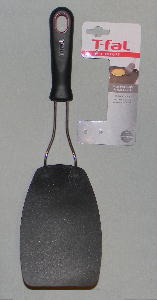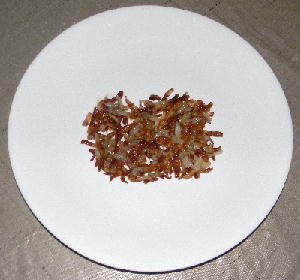

































 One of the utensils that is almost indispensable for cooking hash browns is a large "spatula turner" with a long flexible flat solid plastic end that measures 6 inches by 4 inches. It is just the right size to get completely under a layer of hash browns in a skillet so they can be turned over without some of the hash browns falling off the spatula. Because the end is a little bit flexible it can be used near the outside edge of a skillet and pressed down so the leading edge bends and slides under the item that needs to be flipped. This type of spatula is also extremely useful when making omelets, pancakes, or other items that can fall apart as they are being flipped over. The "spatula turner" in the picture on the right costs $5.97 at Walmart.
One of the utensils that is almost indispensable for cooking hash browns is a large "spatula turner" with a long flexible flat solid plastic end that measures 6 inches by 4 inches. It is just the right size to get completely under a layer of hash browns in a skillet so they can be turned over without some of the hash browns falling off the spatula. Because the end is a little bit flexible it can be used near the outside edge of a skillet and pressed down so the leading edge bends and slides under the item that needs to be flipped. This type of spatula is also extremely useful when making omelets, pancakes, or other items that can fall apart as they are being flipped over. The "spatula turner" in the picture on the right costs $5.97 at Walmart.| 2 cups potatoes, shredded | 2 cups ice cold water |
| 8 teaspoons butter, for frying, 1 teaspoon at a time | 1/2 teaspoon iodized salt, plus salt for sprinkling |
 Spatula: A turning spatula with a soft flexible flat solid end that is 6 inches long and 4 inches wide is very useful for cooking hash browns. This type of spatula can be purchased for about $6 at Walmart.
Spatula: A turning spatula with a soft flexible flat solid end that is 6 inches long and 4 inches wide is very useful for cooking hash browns. This type of spatula can be purchased for about $6 at Walmart.
